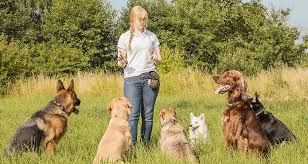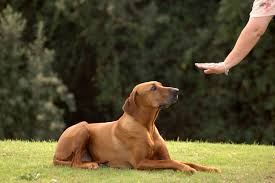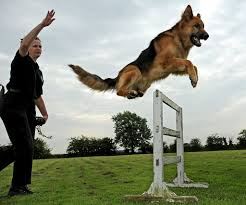Welcome back! I hope that everyone had a terrific spring break and relaxed in the sun! I know that you missed it, so here we are back again with a new Blog of Dogs! This week, we are going to focus on how to train your precious pooches. As we have talked about before, dogs are very smart and are capable of being trained to do many different things. If you want to train your dog to the best of their abilities, then you need to train them properly and effectively. With this, this blog is going to give you the best tips and tricks to train your dog.
There are so many different ways to train dogs. Some people take the “firm hand” approach while others take the “alpha dog” approach. With this, all dogs are different and different breeds respond better to different training approaches. However, there are some basics that need to be shown in every type of training. These basic training tips are: rewarding behaviors you like and making sure behaviors that are not favorable are not rewarded. Other than these two important tips, you can really choose how to train your dog in your own way. It might take a while to figure out the best way to train your own specific dog so here are some tips to start you on the right track to training your new family member.
- Listen to your dog.
- Make sure that you are paying attention to your dog and what they want. If they seem uncomfortable for some reason, listen and respect that and try to fix whatever is making your dog upset.
- Show your dog proper affection.
- While many people do not necessarily have a problem showing when they are unhappy with their dogs, it is much harder to show appreciation and love when their dog does something right. With this, make sure that you give your dog a lot of positive attention and love when they do something right. Dogs love pleasing those they love so when they are being praised for something they did, it is the best way to encourage a certain type of behavior.
- Be consistent.
- Life can be confusing for a new puppy with so many stimuli and noises around them so it is very important to be as steady as possible with your dog. With this, it is important to make sure that the whole family is as involved in training the dog and not just one main family member. If someone yells at the dog when he jumps on the couch and then someone lets the dog up on the couch another day, it can very confusing for the dog and be detrimental to their training.
- Be realistic with your expectations.
- Training a dog is not easy, it is a big job that can take a lot of time and effort. Dogs have behaviors that are natural to them, like barking, digging, and jumping, that can take a long time to stop a dog from doing. Have patience with your dog and try not to get too frustrated.
- You get what you reinforce which is not always what you want.
- If your dog exhibits a behavior that is unfavorable, it is likely that the action was something that has been reinforced before. For example, if your dog brings you a toy and then barks at you to throw it and then you do, this teaches the dog to bark to get what they want. To stop this type of behavior, you must ignore his barking or ask him to do something, like sit, before throwing the toy. This way, you are not responding to his bark rewarding him for obeying you.
Now that you know the tips to training your dog, here are some basic commands that are very important for your dog to learn:
- Sit
- This command allows you to be able to get control of your dog, no matter what situation. This is a very good command to teach your dog first.
- Drop
- This command teaches your dog to drop whatever is in their mouth. This is an important command because it could save your dog from harm if they ever pick up something poisonous or dangerous.
- Stay
- This command teaches your dog to remain still and calm and in one place. This is good for when you are handling food or if there is a car around your dog.
- Heel
- This command teachers your dog to stay close to you as you walk. This is very useful for keeping your dog under control while you are going on walks.
- Come
- This command teaches your dog to come to you on your command. This command is important to teach your dog as soon as they learn their own name. This command keeps your dog under control and cna keep your dog from harm.
I hope that this blog was helpful in training your dog! Good luck and have fun with your new pup!!





I am not sure if I’ve told you before but sadly, I am allergic to dogs. When I was in 5th or 6th grade, my parents took our my siblings and I to a toy poodle dog breeder near us. I really enjoyed playing with the dogs and did not have any allergic reaction whatsoever because the dogs were hypoallergenic. Once we arrived home, my mom, however, crushed me by saying we would not purchase a dog. My sister cried and I was angry that we even went to the breeder. Clearly, I have a bad, depressing experience with dogs; yet, I still really like playing with dogs and I think that by training a dog, you can really get the most out of them. They are fun to play with and I really like the structure of your blog post and how easy it is to read. By starting with some tips about dog training, the reader really knows what to expect. My friends have told me that training dogs is a daunting task and you make it clear in the post. My favorite trick a dog can learn is probably the wave or paw. I have no idea how they just learn how to do these tricks but they are so cool! Overall, great job and I can’t wait to read your blog again.
Great article, and I am totally an advocate of positive reinforcement for dog training.
I have been an Animal Behaviourist and Enrichment Expert for over 30 years and have seen some terrible people ‘train’ dogs.
But thankfully the world is beginning to understand more about our relationship with animals and how we can live in harmony together.
Where would we be without our pet companions and work colleagues.
You can read more about me, training and enrichment ideas on my blog at http://www.rufflesnuffle.co.uk.